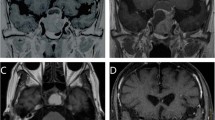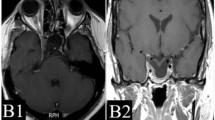Abstract
The aim of the present study was to evaluate the safety and feasibility of hypofractionated stereotactic radiotherapy (SRT) with CyberKnife for growth hormone-secreting pituitary adenoma (GH-PA). Fifty-two patients with GH-PA were treated with hypofractionated SRT between September 2001 and October 2012. Eight patients had clinically silent GH-PA and 44 were symptomatic. Only 1 patient was inoperable. The other patients had recurrent or postoperative residual tumors on MRI. All patients had received pharmacotherapy prior to SRT with a somatostatin analog, dopamine agonist, and/or GH receptor antagonist. The marginal doses were 17.4–26.8 Gy for the 3-fraction schedule and 20.0–32.0 Gy for the 5-fraction schedule. Endocrinological remission was assessed by the Cortina consensus criteria 2010 (random GH <1 ng/ml or nadir GH after an oral glucose tolerance test <0.4 ng/ml and normalization of age- and sex-adjusted insulin-like growth factor-1). The median follow-up period was 60 months (range 27–137). The 5-year overall survival, local control, and disease-free survival rates were 100, 100, and 96 %, respectively. Nine patients (5 clinically silent and 4 symptomatic patients) satisfied the Cortina criteria without receiving further pharmacotherapy, whereas the remaining 43 patients did not. No post-SRT grade 2 or higher visual disorder occurred. Symptomatic post-SRT hypopituitarism was observed in 1 patient. CyberKnife hypofractionated SRT is safe and effective when judged by imaging findings for GH-PA. However, it may be difficult to satisfy the Cortina consensus criteria in most symptomatic patients with SRT alone. Further investigations of optimal treatments are warranted.



Similar content being viewed by others
References
Ezzat S, Asa SL, Couldwell WT, Barr CE, Dodge WE, Vance ML, McCutcheon IE (2004) The prevalence of pituitary adenomas: a systematic review. Cancer 101:613–619
Sivakumar W, Chamoun R, Nguyen V, Couldwell WT. Incidental pituitary adenomas (2011) Neurosurg Focus 31:E18. doi:10.3171/2011.9.FOCUS11217
Wade AN, Baccon J, Grady MS, Judy KD, O’Rourke DM, Snyder PJ (2011) Clinically silent somatotroph adenomas are common. Eur J Endocrinol 165:39–44. doi:10.1530/EJE-11-0216
Mayson SE, Snyder PJ (2015) Silent pituitary adenomas. Endocrinol Metab Clin N Am 44:79–87. doi:10.1016/j.ecl.2014.11.001
Schneider HJ, Sievers C, Saller B, Wittchen HU, Stalla GK (2008) High prevalence of biochemical acromegaly in primary care patients with elevated IGF-1 levels. Clin Endocrinol (Oxf) 69:432–435. doi:10.1111/j.1365-2265.2008.03221.x
Bengtsson BA, Edén S, Ernest I, Odén A, Sjögren B (1988) Epidemiology and long-term survival in acromegaly. A study of 166 cases diagnosed between 1955 and 1984. Acta Med Scand 223:327–335
Rosario PW (2011) Frequency of acromegaly in adults with diabetes or glucose intolerance and estimated prevalence in the general population. Pituitary 14:217–221. doi:10.1007/s11102-010-0281-0
Bihan H, Espinosa C, Valdes-Socin H, Salenave S, Young J, Levasseur S, Assayag P, Beckers A, Chanson P (2004) Long-term outcome of patients with acromegaly and congestive heart failure. J Clin Endocrinol Metab 89:5308–5313
Damjanovic SS, Neskovic AN, Petakov MS, Popovic V, Vujisic B, Petrovic M, Nikolic-Djurovic M, Simic M, Pekic S, Marinkovic J (2002) High output heart failure in patients with newly diagnosed acromegaly. Am J Med 112:610–616
Barrande G, Pittino-Lungo M, Coste J, Ponvert D, Bertagna X, Luton JP, Bertherat J (2000) Hormonal and metabolic effects of radiotherapy in acromegaly: long-term results in 128 patients followed in a single center. J Clin Endocrinol Metab 85:3779–3785
Jenkins PJ, Bates P, Carson MN, Stewart PM, Wass JA (2006) Conventional pituitary irradiation is effective in lowering serum growth hormone and insulin-like growth factor-I in patients with acromegaly. J Clin Endocrinol Metab 91:1239–1245
Attanasio R, Epaminonda P, Motti E, Giugni E, Ventrella L, Cozzi R, Farabola M, Loli P, Beck-Peccoz P, Arosio M (2003) Gamma-knife radiosurgery in acromegaly: a 4-year follow-up study. J Clin Endocrinol Metab 88:3105–3112
Wang MH, Liu P, Liu AL, Luo B, Sun SB (2003) Efficacy of gamma knife radiosurgery in treatment of growth hormone-secreting pituitary adenoma. Zhonghua Yi Xue Za Zhi 83:2045–2048
Ikeda H, Jokura H, Yoshimoto T (2001) Transsphenoidal surgery and adjuvant gamma knife treatment for growth hormone-secreting pituitary adenoma. J Neurosurg 95:285–291
Giustina A, Chanson P, Bronstein MD, Klibanski A, Lamberts S, Casanueva FF, Trainer P, Ghigo E, Ho K, Melmed S (2010) Acromegaly consensus group: A consensus on criteria for cure of acromegaly. J Clin Endocrinol Metab 95:3141–3148. doi:10.1210/jc.2009-2670
Leber KA, Berglöff J, Pendl G (1998) Dose-response tolerance of the visual pathways and cranial nerves of the cavernous sinus to stereotactic radiosurgery. J Neurosurg 88:43–50
Stafford SL, Pollock BE, Leavitt JA, Foote RL, Brown PD, Link MJ, Gorman DA, Schomberg PJ (2003) A study on the radiation tolerance of the optic nerves and chiasm after stereotactic radiosurgery. Int J Radiat Oncol Biol Phys 55:1177–1181
Hoban PW, Jones LC, Clark BG (1999) Modeling late effects in hypofractionated stereotactic radiotherapy. Int J Radiat Oncol Biol Phys 43:199–210
Iwata H, Sato K, Tatewaki K, Yokota N, Inoue M, Baba Y, Shibamoto Y (2011) Hypofractionated stereotactic radiotherapy with CyberKnife for nonfunctioning pituitary adenoma: high local control with low toxicity. Neuro Oncol 13:916–922. doi:10.1093/neuonc/nor055
Iwata H, Tatewaki K, Inoue M, Yokota N, Baba Y, Nomura R, Shibamoto Y, Sato K (2012) Single and hypofractionated stereotactic radiotherapy with CyberKnife for craniopharyngioma. J Neurooncol 106:571–577. doi:10.1007/s11060-011-0693-3
Inoue M, Shiomi H, Iwata H, Taguchi J, Okawa K, Kikuchi C, Inada K, Iwabuchi M, Murai T, Koike I, Tatewaki K, Ohta S, Inoue T (2015) Development of system using beam’s eye view images to measure respiratory motion tracking errors in image-guided robotic radiosurgery system. J Appl Clin Med Phys 16:5049. doi:10.1120/jacmp.v16i1.5049
Antypas C, Pantelis E (2008) Performance evaluation of a CyberKnife G4 image-guided robotic stereotactic radiosurgery system. Phys Med Biol 53:4697–4718. doi:10.1088/0031-9155/53/17/016
Shaw E, Kline R, Gillin M, Souhami L, Hirschfeld A, Dinapoli R, Martin L (1993) Radiation therapy oncology group: radiosurgery quality assurance guidelines. Int J Radiat Oncol Biol Phys 27:1231–1239
Paddick I (2000) A simple scoring ratio to index the conformity of radiosurgical treatment plans. Technical note. J Neurosurg 93:S219–S222
Fukuoka S, Ito T, Takanashi M, Hojo A, Nakamura H (2001) Gamma knife radiosurgery for growth hormone-secreting pituitary adenomas invading the cavernous sinus. Stereotact Funct Neurosurg 76:213–217
Kobayashi T (2009) Long-term results of stereotactic gamma knife radiosurgery for pituitary adenomas. Specific strategies for different types of adenoma. Prog Neurol Surg 22:77–95. doi:10.1159/000163384
Lee CC, Vance ML, Xu Z, Yen CP, Schlesinger D, Dodson B, Sheehan J (2014) Stereotactic radiosurgery for acromegaly. J Clin Endocrinol Metab 99:1273–1281. doi:10.1210/jc.2013-3743
Yan JL, Chang CN, Chuang CC, Hsu PW, Lin JD, Wei KC, Lee ST, Tseng JK, Pai PC, Chen YL (2013) Long-term follow-up of patients with surgical intractable acromegaly after linear accelerator radiosurgery. J Formos Med Assoc 112:416–420. doi:10.1016/j.jfma.2012.01.020
Shibamoto Y, Otsuka S, Iwata H, Sugie C, Ogino H, Tomita N (2012) Radiobiological evaluation of the radiation dose as used in high-precision radiotherapy: effect of prolonged delivery time and applicability of the linear-quadratic model. J Radiat Res 53:1–9
Iwata H, Matsufuji N, Toshito T, Akagi T, Otsuka S, Shibamoto Y (2013) Compatibility of the repairable-conditionally repairable, multi-target and linear-quadratic models in converting hypofractionated radiation doses to single doses. J Radiat Res 54:367–373. doi:10.1093/jrr/rrs089
Naritaka H, Kameya T, Sato Y, Furuhata S, Otani M, Kawase T (1999) Morphological characterization and subtyping of silent somatotroph adenomas. Pituitary 1:233–241
Mohammed S, Syro L, Abad V, Salehi F, Horvath E, Scheithauer BW, Kovacs K, Cusimano M (2009) Silent somatotroph adenoma of the pituitary in an adolescent. Can J Neurol Sci 36:123–125
Cooper O (2015) Silent corticotroph adenomas. Pituitary 18:225–231. doi:10.1007/s11102-014-0624-3
Lee CC, Vance ML, Lopes MB, Xu Z, Chen CJ, Sheehan J (2015) Stereotactic radiosurgery for acromegaly: outcomes by adenoma subtype. Pituitary 18:326–334. doi:10.1007/s11102-014-0578-5
Mori R, Inoshita N, Takahashi-Fujigasaki J, Joki T, Nishioka H, Abe T, Fujii T, Yamada S (2013) Clinicopathological features of growth hormone-producing pituitary adenomas in 242 acromegaly patients: classification according to hormone production and cytokeratin distribution. ISRN Endocrinol 2013:723432. doi:10.1155/2013/723432
Landolt AM, Haller D, Lomax N, Scheib S, Schubiger O, Siegfried J, Wellis G (2000) Octreotide may act as a radioprotective agent in acromegaly. J Clin Endocrinol Metab 85:1287–1289
Acknowledgments
The authors are grateful to Mr. Kosaku Inada, Mr. Manabu Senda, Mr. Kohei Okawa, and Ms. Kumiko Ogawa for their valuable help in this research.
Financial disclosure
The authors declare that they are not involved in any relationships with companies or organizations that make products related to this study.
Author information
Authors and Affiliations
Corresponding author
Ethics declarations
Conflict of interest
No conflicts of interest exist for any of the authors.
Ethical standards
The study was conducted in accordance with the Declaration of Helsinki and complies with the current laws of the countries in which it was performed. An independent ethics committee or institutional review board for each study site approved the study protocol. Informed consent was obtained from all individual patients included in the study.
Rights and permissions
About this article
Cite this article
Iwata, H., Sato, K., Nomura, R. et al. Long-term results of hypofractionated stereotactic radiotherapy with CyberKnife for growth hormone-secreting pituitary adenoma: evaluation by the Cortina consensus. J Neurooncol 128, 267–275 (2016). https://doi.org/10.1007/s11060-016-2105-1
Received:
Accepted:
Published:
Issue Date:
DOI: https://doi.org/10.1007/s11060-016-2105-1




